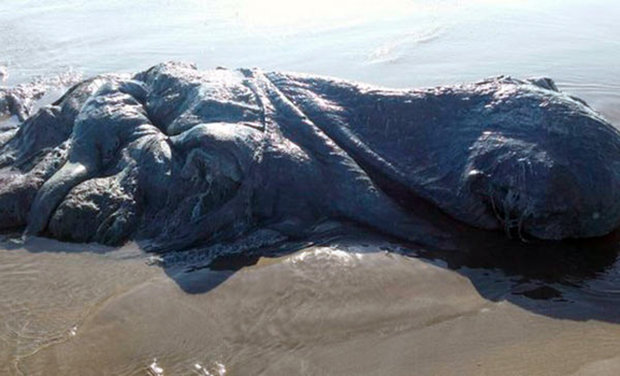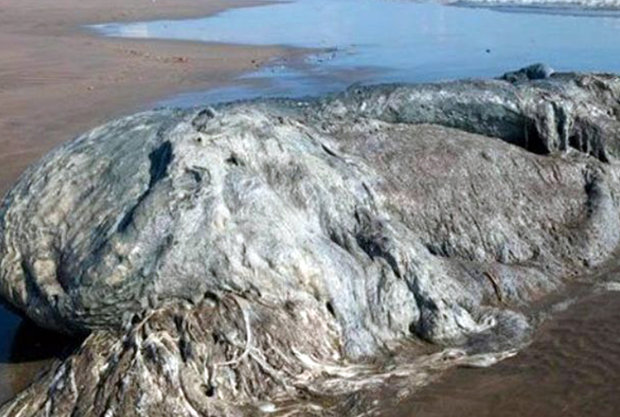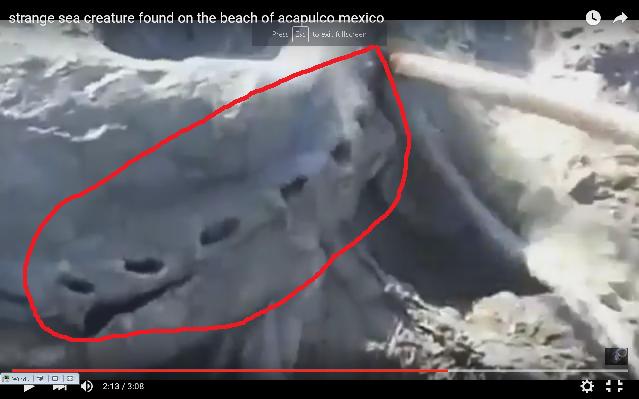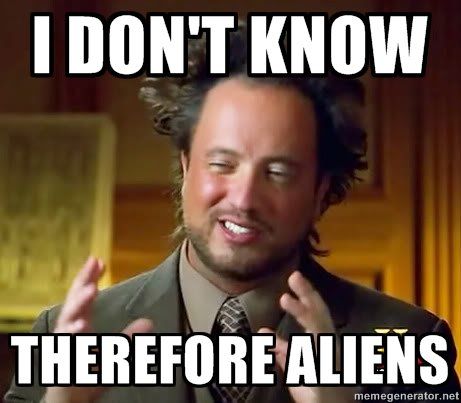It looks like you're using an Ad Blocker.
Please white-list or disable AboveTopSecret.com in your ad-blocking tool.
Thank you.
Some features of ATS will be disabled while you continue to use an ad-blocker.
share:
Mystery monster sea blob washes up on beach and terrifies tourists
www.dailystar.co.uk...
March 10, 2016


I found a youtube video on this creature caught on the beach....
It does appear to have tentacles or tentacle-like features that may have decayed away...

..and therefore it really could be a giant squid from the looks of it. But when it is not fully dissected or body parts separated to see...how else can you identify for now what it could be?
Mysterious 4-metre long sea monster found washed up dead on beach baffles experts
www.mirror.co.uk...
At first look I thought this was looking like some mangled octopus instead by judging the blobbiness of the "head" and length of the body. Then I thought maybe it could be a whale but there was really no sign of a whale fin or tale.
It is looking like some weird blob but whatever it could be definitely has a lot of people wondering. What are your thoughts on this ATS?
Maybe it could be some weird form of a jelly fish like this one?
www.dailystar.co.uk...
March 10, 2016

The mysterious creature found itself on Bonfil Beach, in the city of Acapulco, in south-west Mexico.
It is understood the body was brought to shore by strong currents.

I found a youtube video on this creature caught on the beach....
It does appear to have tentacles or tentacle-like features that may have decayed away...

..and therefore it really could be a giant squid from the looks of it. But when it is not fully dissected or body parts separated to see...how else can you identify for now what it could be?
Mysterious 4-metre long sea monster found washed up dead on beach baffles experts
www.mirror.co.uk...
The odd-looking beast, a huge four metres long, was found by sun worshippers on Bonfil Beach, in the city of Acapulco, in the south-west Mexican state of Guerrero.
The floating body was brought to the shore by strong currents that have been affecting that particular part of the Mexican coast.
Rosa Camacho, believes the animal had not been dead for a long time, it still seemed to have rapidly started to decay.
"We have no idea what type of animal this is, but I do know that it does not smell bad or have a fetid aroma.
"It is four metres long and was found on Bonfil Beach."
Some have suggested that the creature might be a type of giant squid and others a whale.
At first look I thought this was looking like some mangled octopus instead by judging the blobbiness of the "head" and length of the body. Then I thought maybe it could be a whale but there was really no sign of a whale fin or tale.
It is looking like some weird blob but whatever it could be definitely has a lot of people wondering. What are your thoughts on this ATS?
Maybe it could be some weird form of a jelly fish like this one?
edit on 10-3-2016 by Skywatcher2011 because: edit note
a reply to: zazzafrazz
If it was whale vomit or snot or hoyik then that's amber gris worth mega money.
If it was whale vomit or snot or hoyik then that's amber gris worth mega money.
a reply to: Cloudbuster
Yeah I read once it is better than finding gold financially, can't remember why, and am not sure if it even looks like it.
Yeah I read once it is better than finding gold financially, can't remember why, and am not sure if it even looks like it.
a reply to: Skywatcher2011
Looks like a giant deflated octopus to me. Boy these things are becoming the 'UFOs' of the oceans. Everything washing up on shore that isn't instantly identified is some fantastic mystery creature of the deep.
Looks like a giant deflated octopus to me. Boy these things are becoming the 'UFOs' of the oceans. Everything washing up on shore that isn't instantly identified is some fantastic mystery creature of the deep.
originally posted by: zazzafrazz
Whale vomit?
CAN WHALES VOMIT?
www.whalefacts.org...
The simple answer is yes, whales can and do vomit.
When food or bacteria gets lodged in the whales throat and digestive system it irritates the whales digestive tract and causes it to vomit the trapped food/bacteria out of its mouth in order to clear its throat for other foods and prevent the whale from loosing its ability to properly swallow/digest its food.
Whales do vomit but the vomit does not look like this blob...more like a boulder or stone.
But maybe, just maybe, the whale barfed up an octopus? ???
edit on 10-3-2016 by Skywatcher2011 because: (no reason given)
strange that it has no foul odor.
no ideas at all of what it could be.
no ideas at all of what it could be.
originally posted by: Skywatcher2011
Maybe it could be some weird form of a jelly fish like this one?
forget about the mass your asking about, when tests come back it will just be decomposed whale carcass. What I am curious about is this creature in the video. I want more background on that thing, because it is displaying some amazing properties.
a reply to: AmericanRealist
I was thinking about making a thread on that jellyfish when I was reading into this blob article...but I can leave that up to you. Just know this jellyfish was spotted in the deep waters in Mexico. Hope to read a thread on this by you sometime
I was thinking about making a thread on that jellyfish when I was reading into this blob article...but I can leave that up to you. Just know this jellyfish was spotted in the deep waters in Mexico. Hope to read a thread on this by you sometime
a reply to: AmericanRealist
It's a jellyfish called Deepstaria Enigmatica.
Mystery solved: Curious blob filmed in the deep revealed to be a giant jelly fish (not a whale placenta)
Absurd Creature of the Week: Don’t You Dare Call the Deepstaria Jellyfish a Whale Placenta
One more link to an interesting article about it:
Solving the Mystery of the Placental Jellyfish
It's a jellyfish called Deepstaria Enigmatica.
When a Youtube video of the creature was posted last month speculators suggested it was everything from the remains of a whale placenta to a fishing net. However, experts have now confirmed that the ‘sea monster’ is, in fact, a rarely studied jelly fish known as Deepstaria Enigmatica.
The jellyfish was reportedly filmed during deep-sea drilling near the United Kingdom. The species is usually found approximately 5,000 feet below in the south Atlantic Ocean.
Mystery solved: Curious blob filmed in the deep revealed to be a giant jelly fish (not a whale placenta)
Roaming the oceans are two species of Deepstaria, named after the submersible Deepstar that first spotted one intact in the 1960s. Deepstaria reticulum, shown at top, features that beautiful red hue, while the other, Deepstaria enigmatica, appears whiter. Otherwise, they look largely the same.
“Most jellies would have a relatively small bell and then relatively long tentacles,” says Steven Haddock, a biologist at the Monterey Bay Aquarium Research Institute. “These guys have the really big bell that’s almost like a trash bag or something, and pretty much no tentacles.”
Absurd Creature of the Week: Don’t You Dare Call the Deepstaria Jellyfish a Whale Placenta
One more link to an interesting article about it:
Solving the Mystery of the Placental Jellyfish
edit on 10-3-2016 by Casandra because: Typo
N/M shared above!
What I was saying it didn't look squid like in comparison to washed up squid images. It being a jellyfish makes more sense.
What I was saying it didn't look squid like in comparison to washed up squid images. It being a jellyfish makes more sense.
edit on 10-3-2016
by dreamingawake because: (no reason given)
I've actually been diving near one of these things, the only difference is the one I came across was singing show tunes underwater.
Seriously though, there are some amazing and apparently "otherworldly" creatures in the deep sea.
That said, if you consider it, the deep sea IS another world compared to what we experience up here on dry land.
If you've dived into the deep waters of the warm oceans you'd know what I mean.
Seriously though, there are some amazing and apparently "otherworldly" creatures in the deep sea.
That said, if you consider it, the deep sea IS another world compared to what we experience up here on dry land.
If you've dived into the deep waters of the warm oceans you'd know what I mean.
a reply to: zazzafrazz
A lot of industries use it for products. I believe it's used in perfume, for one. Think of that the next time you take a spritz.
A lot of industries use it for products. I believe it's used in perfume, for one. Think of that the next time you take a spritz.
Apparently it looks a bit like dog poo. I have friend who found a bit about half the size of your palm or smaller and Ka-Ching $700. It weighs less
than gold I think.a reply to: zazzafrazz
originally posted by: Cloudbuster
Apparently it looks a bit like dog poo. I have friend who found a bit about half the size of your palm or smaller and Ka-Ching $700. It weighs less than gold I think.a reply to: zazzafrazz
From what I remember, it is from sperm whales.
The squid beaks aren't quite digested and are hocked up.
originally posted by: autopat51
strange that it has no foul odor.
no ideas at all of what it could be.
surely.... the rancid stink that usually accompanies bloated bodies is the result of bio-mass decay and gasses made in decomposition....
if it don't stink then it's not the usual mammal or vegetable matter usual in Nature
so, what made the mass of stuff float?
my outlandish guess is we are seeing the creature that lives in the skies and we mistakenly refer to as UFOs
new topics
-
Joe Rogan conspiracy (maybe)
ATS Skunk Works: 2 hours ago -
Results of the use of the Oreshnik missile system in Dnepropetrovsk
World War Three: 4 hours ago -
Nigel Farage now the Most Favoured UK Politician
Regional Politics: 6 hours ago
top topics
-
Results of the use of the Oreshnik missile system in Dnepropetrovsk
World War Three: 4 hours ago, 10 flags -
Little Johnny and Larry should team up
General Chit Chat: 12 hours ago, 9 flags -
Nigel Farage now the Most Favoured UK Politician
Regional Politics: 6 hours ago, 3 flags -
Will Us use alien technology to fight in ww3?
World War Three: 13 hours ago, 2 flags -
Joe Rogan conspiracy (maybe)
ATS Skunk Works: 2 hours ago, 2 flags
active topics
-
President-Elect DONALD TRUMP's 2nd-Term Administration Takes Shape.
Political Ideology • 240 • : WeMustCare -
Results of the use of the Oreshnik missile system in Dnepropetrovsk
World War Three • 127 • : Oldcarpy2 -
Nigel Farage now the Most Favoured UK Politician
Regional Politics • 6 • : angelchemuel -
President-Elect TRUMP Picks Former Florida A.G. PAM BONDI to be U.S. Attorney General.
2024 Elections • 56 • : VariedcodeSole -
Well we know Putins ICBMs won't fail in their silos
World War Three • 209 • : Xtrozero -
Jaguar Rebrand Video Causes "WTF?" Moment - Seriously Weird
Automotive Discussion • 26 • : angelchemuel -
Post A Funny (T&C Friendly) Pic Part IV: The LOL awakens!
General Chit Chat • 7815 • : baddmove -
Joe Rogan conspiracy (maybe)
ATS Skunk Works • 2 • : watchitburn -
Little Johnny and Larry should team up
General Chit Chat • 3 • : bluesman023 -
Will Us use alien technology to fight in ww3?
World War Three • 11 • : BeyondKnowledge3

